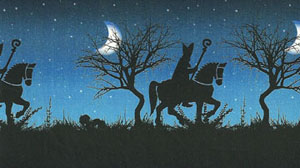Astronoom Peter Barthel onderzoekt sinterklaaspapier: Welke maan schijnt door de bomen?
In een deze maand te verschijnen publicatie in het internationale tijdschrift ‘Communicating Astronomy with the Public’ beschrijft de Groningse sterrenkundehoogleraar Peter Barthel zijn onderzoek naar illustraties van de maan op cadeaupapier en in kinderboeken in Nederland en Amerika.
In veel gevallen staat de halve maan of de maansikkel verkeerd afgebeeld op Nederlands sinterklaaspapier en in kinderboeken: in plaats van de avondmaan met de sikkel aan de rechterkant wordt vaak de ochtendmaan, met de sikkel links, getekend. ‘Dat is fout’, vindt de hoogleraar, ‘want we hebben pakjesavond en niet pakjesochtend’.
De Amerikanen doen het iets beter, maar ook daar komt soms een verkeerde maan voor op Santa Claus illustraties en op kerstkaarten. Ook in boeken rond de thema's Sint Maarten en Halloween heeft Barthel verkeerde manen aangetroffen.
Heerlijk ochtendje?
‘Ik constateer dat een illustrator niet snapt wat hij of zij tekent, want om vier uur 's-ochtends is pakjesavond voorbij en horen kinderen niet meer met een lampion langs de deuren te lopen of de kerstboom te versieren’, zegt Barthel. ‘Mijn onderzoek toont aan dat de leek - in dit geval de illustrator - niet begrijpt hoe de fasen van de maan ontstaan. Dat is natuurlijk ook niet vreselijk belangrijk, maar aan de andere kant is het simpel om te snappen en geeft het een kick als je het wél begrijpt. We zingen ‘het heerlijk avondje is gekomen’, en niet: ‘het heerlijk ochtendje is gekomen’, dus kijk gewoon eens zelf naar buiten hoe die avondmaan er uitziet!’

Hoewel het doen van sterrenkundig onderzoek aan sterrenstelsels en het publiceren daarover het eigenlijke werk van Barthel is, vindt hij wetenschapseducatie en -communicatie zeer belangrijk. ‘Als deze publicatie-met-een-knipoog tot resultaat heeft dat meer mensen snappen dat volle maan opkomt als de zon ondergaat en dat een maansikkel ontstaat doordat de zon van opzij, dat wil zeggen van rechts in de avond en van links in de ochtend, op de maan schijnt, dan zijn de twee weken die dit onderzoek me hebben gekost absoluut de moeite waard geweest’, aldus de sterrenkunde hoogleraar.
Het onderzoek werd uitgevoerd in de periode november 2010-januari 2011.
Prof. dr. Peter Barthel won met een team van onderzoekers en studenten van de Rijksuniversiteit Groningen in 2008 de Academische Jaarprijs voor de beste vertaling van wetenschappelijk onderzoek naar een breed publiek.
Een preprint van het artikel is beschikbaar op: http://arxiv.org/abs/1111.5489
Voor een overzicht van foutief of incorrect sinterklaaspapier en –boeken, zie: http://www.astro.rug.nl/~pdb/santa.html
Meer informatie: prof. dr. Peter Barthel
Meer nieuws
-
11 december 2025
Stormachtige planeten en een onverwachtse atmosfeer
-
09 december 2025
Faculty of Impact Grant voor nieuwe behandeling hersenkanker
